In this house we love every and all types of folk fashion.But I mostly post about Norwegian folk fashion and the bunad because that's what I specialize in
Don't wanna be here? Send us removal request.
Text
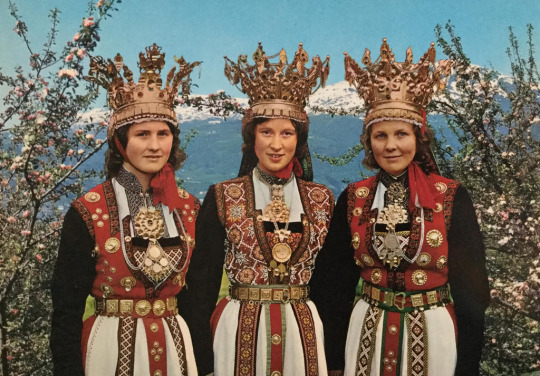

Bunad Basics: the Terminology
What does "bunad" mean? How is it different from a "festdrakt" and what on earth is a "fantasistakk"?
On this blog I use a number of terms that may be confusing if you're not already immersed in the world of historical fashion and traditional Norwegian folk costumes. Since my goal here is to make this world more accessible to anyone who may be interested, I figured I should make a glossary of sorts.
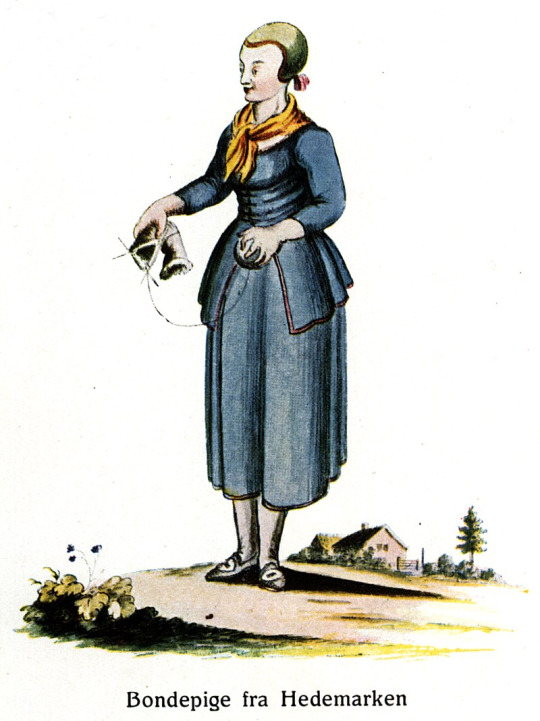

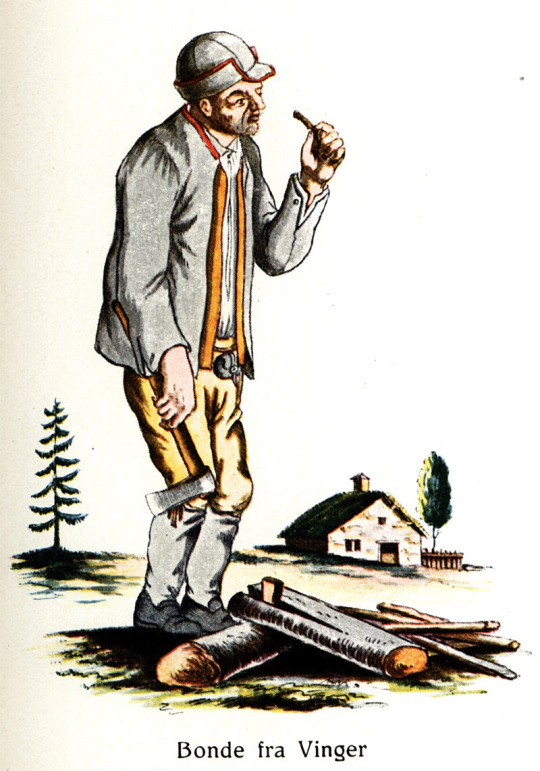
Illustrations by Johan F. L. Dreiers
Folk Costume
This is an umbrella term that refers to any complete costume has been constructed using traditional techniques.
While the word "costume" today has connotations to playing a character in, say, a show -in this context it simply means an outfit.
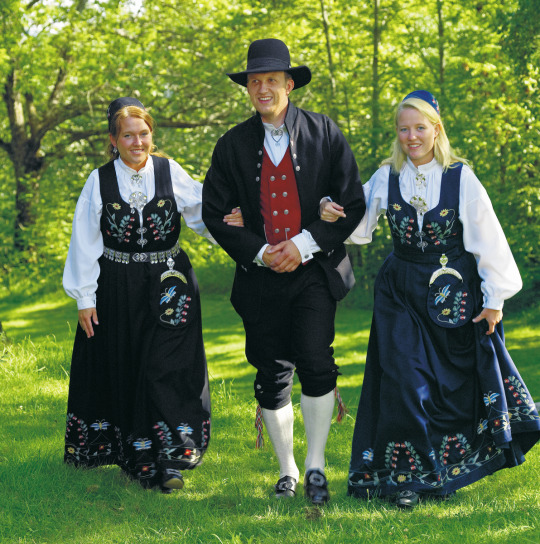
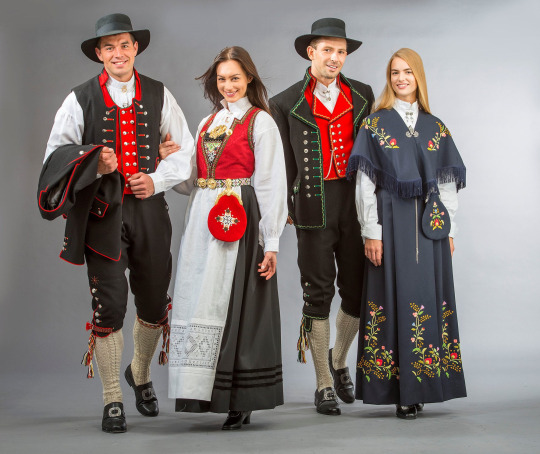
Bunad [bu:`nad]
From old norse: búnaðr. May be directly translated as "to be used at home".
In modern Norwegian the word refers to a type of formal folk costume that represents the traditions of a specific geographical area. The platonic ideal of the bunad is that it should show exactly where you are from, where you consider your "home". Not every adult norwegian has a bunad, but it's common to recieve one from a family member as your 15th birthday gift. You're expected to only own one bunad for the rest of your life (unless you pass it on to the next generation).
There are around 450 distinct bunads in Norway, according to Store Norske Leksikon. While there tends to be a common consensus of what regional traditional costumes are considered real bunads and not, there is no official registry of bunads. The number of 450 is an estimation, and there tends to be disagreements on who is allowed to call their folk costume a bunad.
Some bunads have deep roots and has been in continoous use for hundreds of years, while others are only loosely based on a few archeological finds. The definition is often up for debate.

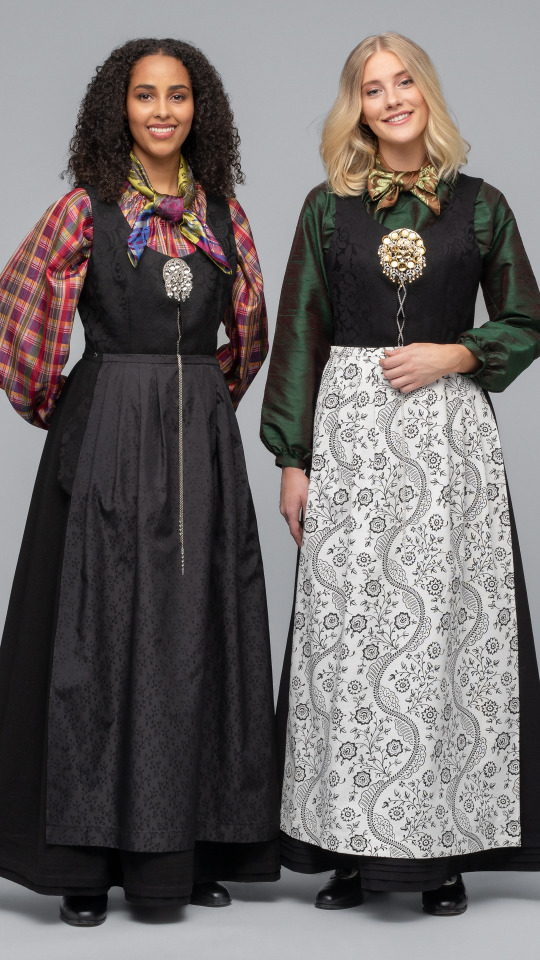
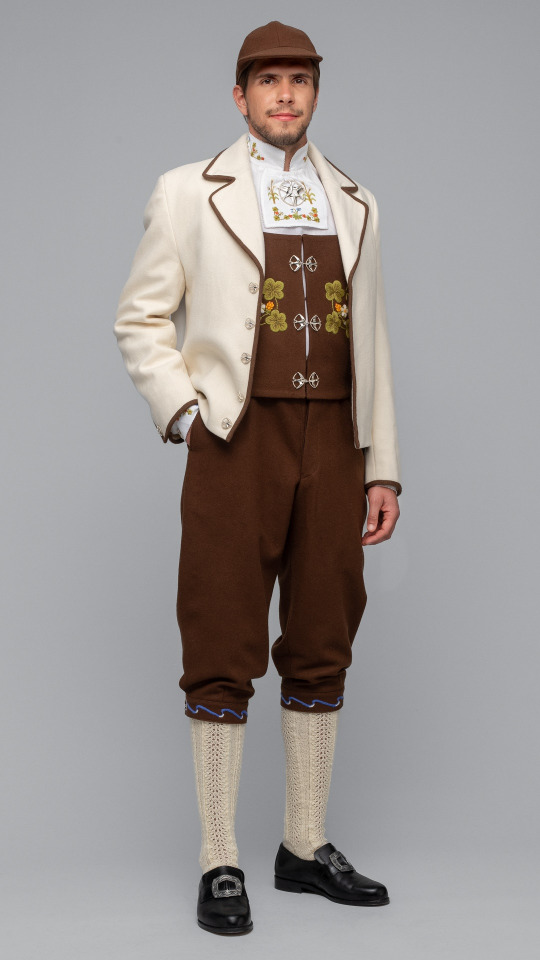
Left to right: Festdrakt originating from Tromsø, Northern Norway, and Senja
Festdrakt
May be directly translated as "celebration-costume".
A festdrakt is a formal traditional outfit that is not considered the absolute represenation of a specific geographical area. It may be inspired by local traditions, but has for some reason not been granted recognition as a real bunad.
If you can trace the composition of a folk costume back to a specific designer, it will most likely be called a festdrakt. Though a few costumes that fill this requirement are commonly considered bunads regardless.
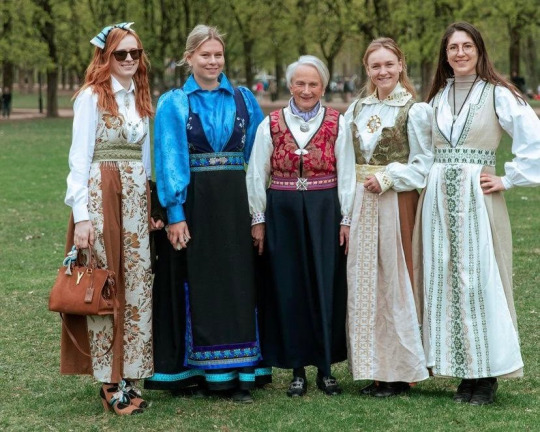
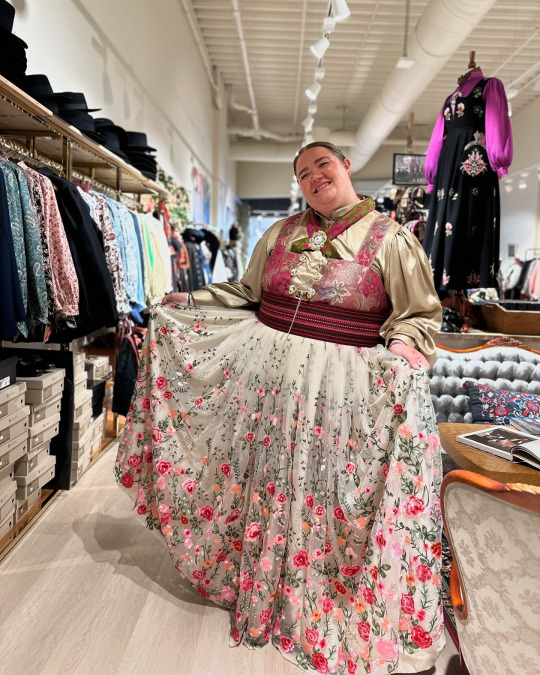
Left: women wearing homemade fantasistakk. Right: woman wearing the fantasistakk "alvedrakt" by fashion house Embla Bunader
Fantasistakk
May be directly translated as "Imagination-dress" or "fantasy-dress".
This is a relatively new term that was born from a modern folk fashion movement. In recent years it has become popular to design a "bunad" from your own imagination, and sew it yourself from any materials you have available.
The motivations behind doing this vary, but a few common reasons are: - wanting to wear something beautiful on important occasions, but not having the money to buy a "real" bunad - feeling overwhelmed about choosing a bunad, so instead going for an option that represents your own personality instead of a specific place of origin - wanting to learn how to sew traditional garments, but being intimidated by the near sacred status of the bunad. - just thinking they look cool
Some fashion houses, like Embla Bunader and Eva Lie have become known for coming up with avant-garde fantasistakk designs.
Bunadspolitiet
Another young term. "The bunad police". This is not an actual authoritarian force, but rather a name for people who feel it's their moral obligation to call out anyone who uses bunad "wrong". Often used as a kind of "boogey man" in discussions about bunad.
These are just a few terms that tend to pop up, if you have any other words you'd like me to explain, ask away!
6 notes
·
View notes
Text









The Norwegian Alvedrakt, a new Norwegian folk dress from Embla Bunader
Im honestly so in love with this, and if i didn't already have a bunad, this would be my first choice!
57 notes
·
View notes
Text

🚨BUNAD MISTAKE SPOTTED🚨
The girl to the left is wearing a Vestfold bunad with a støle-belt. Her vest is laced closed with a silver chain. This is CORRECT. She is wearing all the necessary pieces for a complete bunad. If she wanted to add more details to her outfit, she could add a hat or headband, a silk kerchief, and a cape, but the outfit fits her well and she seems happy in it, so those are just suggestions.
Her friend to the right, however, is dressed in an Eastern Telemark bunad. This bunad does not have a leather belt, but a tablet woven one. She is not wearing a jacket, but she is wearing the jacket's silver brooches, pinned to her belt. this is NOT CORRECT. Trust me, I understand the urge to show off all your silver even though it's too warm for a jacket. But please do not do this! This damages your belt!! Telemark in particular has a tendency to layer so much stuff on top of each other that there will always be beautiful details of your bunad that are hidden from onlookers. That's part of its charm. Learn to embrace it. Do not ruin your woven belt with pins. I would also advise her to not carry as much in her pocket, as it too is tugging on her belt in a way that might tear on it over time. But I must say, her red silk Kerchief is a nice touch to her otherwise relatively plain bunad.
#bunad#I could comment indefinitely on small details. but I'm choosing to focus on things that are damaging#remember that it's supposed to last you a lifetime#also I don't want to 'correct' how anyone wears a bunad#it feels extremely rude#complete bunad#øst-telemark#vestfold#2000s#2020s#telemark#this was originally going to be a reblog but turns out OP was uh. someone I'd rather not give a shoutout like this#so I took their already stolen image and made my own post
2 notes
·
View notes
Text
bunad-daily -> folketro
new blog name!
I realized that having the word "bunad" in my url was limiting me.
In reality, I'm not too fond of the bunad. I have my own, and I love wearing it, but the fact that it is a bunad specifically doesn't mean anything to me.
I may be biased because I have Sámi and Tater heritage, but to me the ideal of the bunad feels borderline opressive. the bunad is the standardization of culture. In search of identity, the norwegians went looking for folk art. They found thriving, diverse craftmanship made by individuals. They then took the parts they found appealing, and made "one true bunad" for each region. In a way, that shows off the same ideal that was behind the assimilation politics; the want for a mono-cultural nation.
Of course there is nuance. Of course there are good aspects of the bunad. It did help preserve traditions in many areas where it was about to get washed out by industrialization. It helped norwegians reconnect with their culture after being ruled by other nations for centuries. Of course.
But, the bunad does not represent what draws me to Norwegian folk fashion. The bunad is kept behind paywalls and trademarked designs. The bunad wants you to choose a single place of origin. Folk fashion isn't about that. It's art made by living people. It's about survival and creativity. At least that's the parts of it I find interesting.
So I'm changing this blog's name to "folketro", which is the Norwegian word for folklore. Literally it translates to "folk-faith" or "beliefs of the people". The word "tro" can also mean "true", which I think lends itself to a fitting double meaning.
I don't want to view Norwegian folk fashion through the rose tinted glasses of bunad, I want this blog to be true to the spirit of the people. I want to both promote the positives and discuss the negatives of my culture. the new name also gives me more wriggle room in the sense that it allows me to talk about more cultures than just one.
I post about Norwegian folk fashion a lot because that's what I know and specialize in, but I'd love to learn about folk fashion from other places as well. I'd also like to talk about other cultures within Norway, but I would feel weird bringing up Sámi doudje on a bunad-centric blog. I wouldn't want to feed into the misconception that Sámi gappte are bunads.
So, in conclusion: I will keep posting about bunad, because it really is a cornerstone of Norwegian folk fashion, but I didn't want to feel obligated to only talk about bunad, so I changed the blog name.
#bunad daily housekeeping#<- will have to change that tag as well#it's a work in progress#this blog is run by a pragmatic daughter of an assimilated Sámi family#just so you know
2 notes
·
View notes
Text








The "Rosemaling" collab between fashion house Embla Bunader and skateboard company SHIT
In 2020, Embla Bunader and SHIT released the "Rosemaling" collection of hoodies, t-shirts and skate decks. The designs are by Torhild Lambersøy, mother-in-law to the founder of Embla Bunader.
Full article about the collection (in Norwegian) English translation of the article
#embla bunader#SHIT#rosemaling#modern folk fashion#bunad#street fashion#2000s#2020s#currently working on a translation of the article because I think it highlights a lot of things about#norwegians' relationship to the bunad
4 notes
·
View notes
Text
oh. the bunad tag is dead dead. I see.
1 note
·
View note
Text
She hopes the "Bunad Police" won’t scold the new skater clothes.
A translation of this article (in Norwegian)
For the last year, Embla bunader and the clothes brand SHIT have been working together on the “everyday bunad”. But messing with tradition may stir some strong emotions.

Bunad tradition meets skater culture. Skateboard company SHIT and Embla bunader just dropped their skaters’ collection. Photo: Embla bunader
Article by Håvard Tanche-Larsen Knutsen, Published: 13. July 2020 translated by bunad-daily.tumblr.com
“This is a minefield. One time we made hijab for a bunad, and got death threats,” - manager of Embla bunader: Marianne Lambersøy.
The afformented incident was reported to the authorities, but Lambersøy feels sure that this new idea will not be as contoversial.
The bunad shop, together with the local clothes brand SHIT, have now designed hoodies, t-shirts, and skateboards with bunad designs.
No angry Telemark-folks.
This time, local bunad traditions, like the Frafjord and Jelsa patterns, have been left in peace. Lambersøy does not dare mess with them.
Now, the hoodies, t-shirts and skateboards are adorned with rosemaling. A pattern more common on bunads from Telemark, among other areas.
“Norwegians are fond of their bunad, but it’s a garment we tend to only use two times a year. Other countries are good at using traditional patterns on everyday clothes, like shirts and dresses, but here we find it almost exclusively on bunad. That is why we wish to use the rosemaling on everyday garments,” says Lambersøy.
“Have you recieved any reactions from Telemark-folks yet?”
“No, this is a patented pattern, so it is our own. That way we stear clear of conflic with patterns already in use on bunad.”
Rosemaling: Old craft from the 1700s. Mostly used on chests and beer cans, but eventually used to adorn whole rooms in the form of decorations on shelves, beds, doors, and ceilings. Has been an important source of inspiration for many recent norwegian artists. Rosemaling is common in villages around Hallingdal, Telemark, Numedal, Setesdal, and Vest-Agder. Source: Store Norske Leksikon
Rosemaling-artist was a great help
Frode Goa and Lards Horpestad revived the skater brand SHIT last year. Goa also runs the local clothing brand Kant.
The idea of the skater and bunad brands collaborating occured when he was looking to get his own bunad from Lambersøy a year ago.
"The styles clash a bit, so the challenge was to blend them into something we'd consider great. We're very happy with the result," Goa says.

Frode Goa looks through the rosemaling sketches for what now adorns both skateboards and clothes. Photo: private
The duo has gotten great help from Lambersøy's mother in law; Torhild Lambersøy. She has worked with fabrics and fashion since she established her own tailor's shop in Tananger 40 years ago. She was also an active painter of rosemaling, and designed the pattern Goa and Lambersøy use for the clothes and skateboards.
This would be the last project she worked on. She died just before the collection was released.
"In the beginning she was skeptical, but she ended up really enjoying the project. So much so that she sometimes forgot to eat," Lambersøy reminisces with a chuckle.

Goa and Lambersøy stick to rosemaling, a pattern that often appears on bunads from Telemark. They're avoiding patterns from the rogaland-bunad, at least for now.
Not afraid of the "bunad police"
Now, her 12-year-old skates on a board of grandma's design. Old traditional craftsmanship gets to shine in a unique way.
"An original rosemaling design created by a rosemaling expert, used for something so youthful and urban as skateboards and hoodies. It's wild, really," Goa laughs.
"Thoughts on possible reactions from the bunad police?"
"I hope they're overjoyed to see tradition passed on like this. It's real nowergian folk art, is what it is."
"anything else in the works?"
"It's been a really nice project. We're already thinking about it, so there will be more, but we'll have to wait and see what we come up with," Goa concludes.
#bunad#bunad daily translation#modern folk fashion#embla bunader#SHIT#rosemaling#2000s#2020s#I just thought it was a nice article
3 notes
·
View notes
Text
I'm currently in a bit of a modern folk fashion mood so there's going to be a quite a bit of Embla-posting the next few days. I want to get more into the traditional stuff but it takes much longer to research so,,, it will arrive eventually. In the meantime you're getting a look into the riveting tale that is Marianne Lambersøy versus the Bunad Police

#bunad daily housekeeping#Marianne does not appear in this image but she did appear in the debate this image is from#but on a video call so it was a closeup of her face so#this image was better for this post
1 note
·
View note
Photo



Wrote an article about bunads for 17 mai tomorrow! check it out!
76 notes
·
View notes
Text
Article about Ahmed's bunad:
https://www.nrk.no/stor-oslo/norsk-sudanske-ahmed-umars-bunad-inspirerer-til-flerkulturelle-festdrakter-1.16880730
my other Bunad post is getting notes again, apparently this is something you guys find as interesting as I do, so here's another fun one:


the Sudanese-Norwegian visual Artist Ahmed Umar has created two outfits inspired by his multi-cultural heritage.
left: his own Bunad, which is both recognizeably from Hallingdal and Sudan (not sure what specific area though, the article I read didn't say).
right: a Sudanese Toub with fabrics and embroidery inspired by the late Queen Maud's bunad.
Absolutely stunning work, I really hope we get to see more like this
18 notes
·
View notes
Text

Grandma's Wedding Crown
Oil on canvas, 1867, by Adolph Tidemand
89 notes
·
View notes
Text
the Åmlibunad from Åmli, Aust-Agder

#it's so pretty#going to do a deep dive on this one later#åmli#aust-agder#complete bunad#(missing a headpiece but still)
26 notes
·
View notes
Text





Traditional Norwegian hairstyle
Most commonly worn in the Agder region, south-west region of Norway. They are sadly going out of fashion so it's harder to find photos on it. However in the Setesdal region they are more common. I will post about the Setesdal hairstyle too:)
33 notes
·
View notes
Text




I really don't know where else to post this, I just want to share some personal pictures. Anyway this is my classic Vest-Telemark Bunad! I thought I'd share some inspiration for others who also might like the Norwegian folk dress. 🇳🇴✨
25 notes
·
View notes
Text



Traditional Norwegian bride (1966)
This girl is wearing the traditional wedding attire from Telemark, from Telemark county. Eastern part of Norway. Here she is seen wearing a Øst-Telemarkbunad which is the bunad for the eastern part of Telemark county.
44 notes
·
View notes
Text
thanks for the suggestions! "how to wear bunad" tutorials could be really fun (and useful), I could start by covering the most popular types of bunad. how to fasten a bringeduk and where to place the silver are questions I see a lot :]
Sewing techniques are a litte outside my area of knowledge, but that's exactly why I made this blog, so I can research the parts of bunad I know little about! I will absolutely look into it

Filling up the queue with reblogs to buy myself some time to cook up the original posts. If you follow both me and the bunad tag you'll likely see some familiar posts again, but I promise the original stuff is on its way
Right now I'm working on a "History of the Bunad", "Bunad and Folk Costume Terminology Guide", and a series of posts about specific area traditions
I'm open to suggestions, feel free to comment or shoot a message my way if you have any questions or topics you'd like me to cover :3
3 notes
·
View notes
Text
Norwegian brides
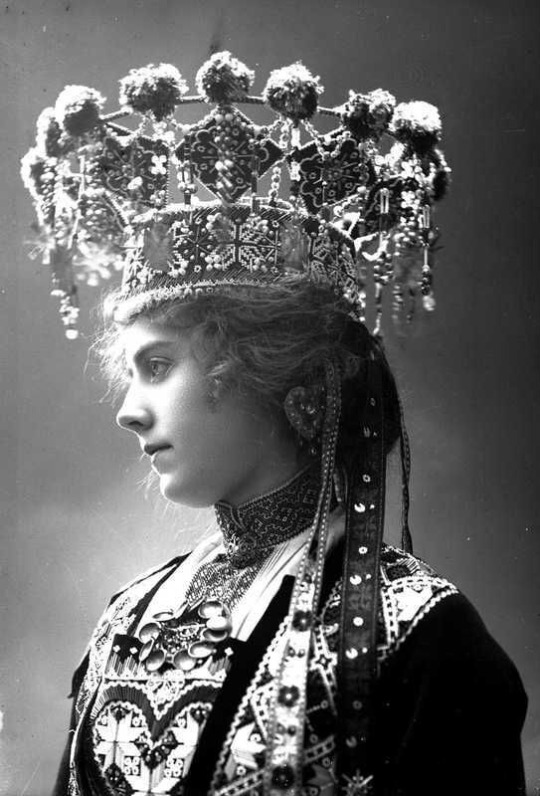

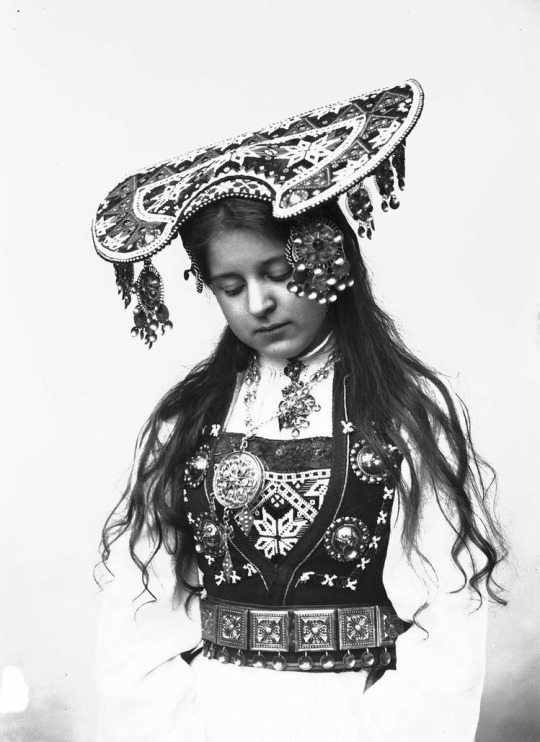

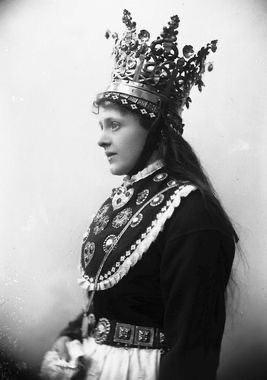
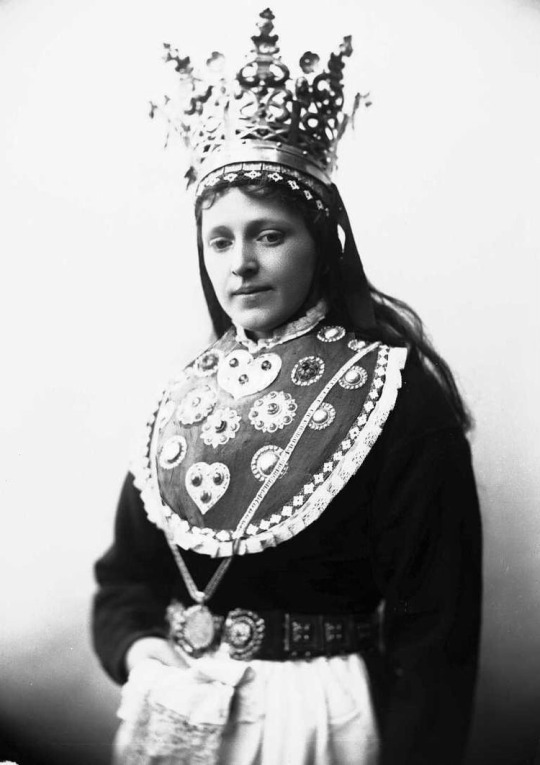

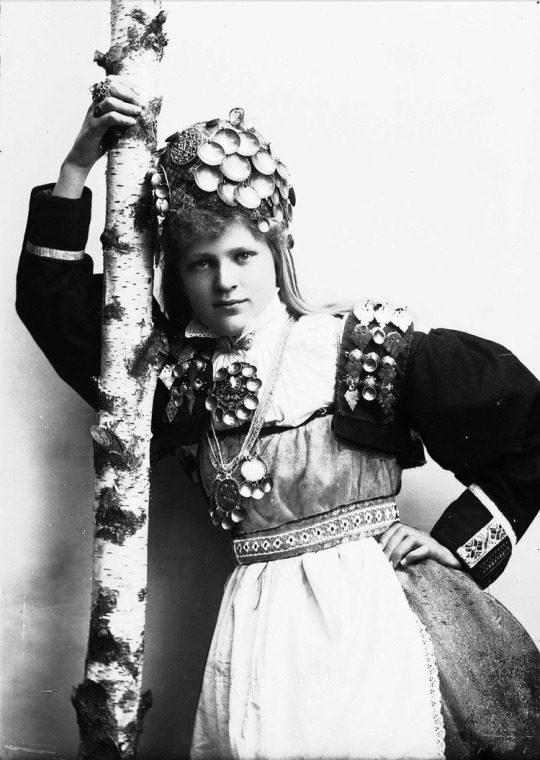
Traditional Norwegian bridal-wear usually consists of the areas’ folkclothing, jewelry; and a bridal crown/headdress. There exist multiple bridal crowns in Norway, made out of: gold, silver, metal, feathers, beads, textiles, etc.
1 & 2 photos; brides wearing beaded bridal crowns from Hardanger (perlekrone frå Hardanger)
3 & 4 photos; bride wearing a flat, beaded bridal crown from Voss
5 & 6 photos; bride wearing (gold or silver) bridal crown from Sogn
7 & 8 photos; brides wearing bridal headdress from Setesdal
Sources; all pictures are taken from digitaltmuseum.no. Photographer; Solveig Lund.
132 notes
·
View notes